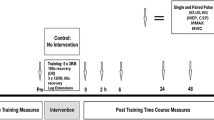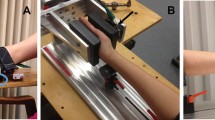Abstract
Purpose
To test whether long-term cortical adaptations occur bilaterally following chronic unilateral training with a simple motor task.
Methods
Participants (n = 34) were randomly allocated to a training or control groups. Only the former completed a 4-week maximal-intensity isometric training of the right first dorsal interosseus muscle through key pinching. Maximal strength was assessed bilaterally in four different movements progressively less similar to the training task: key, tip and tripod pinches, and handgrip. Transcranial magnetic stimulation was used to probe, in the left and right primary hand motor cortices, a number of standard tests of cortical excitability, including thresholds, intra-cortical inhibition and facilitation, transcallosal inhibition, and sensory-motor integration.
Results
Training increased strength in the trained hand, but only for the tasks specifically involving the trained muscle (key +8.5 %; p < 0.0005; tip +7.2 %; p = 0.02). However, the effect size was small and below the cutoff for meaningful change. Handgrip and tripod pinch were instead unaffected. There was a similar improvement in strength in the untrained hand, i.e., a cross-education effect (key +6.4 %; p = 0.02; tip +4.7 %; p = 0.007). Despite these changes in strength, no significant variation was observed in any of the neurophysiological parameters describing cortico-spinal and intra-cortical excitability, inter-hemispheric inhibition, and cortical sensory-motor integration.
Conclusions
A 4-week maximal-intensity unilateral training induced bilaterally spatial- and task-specific strength gains, which were not associated to direct or crossed cortical adaptations. The observed long-term stability of neurophysiological parameters might result from homeostatic plasticity phenomena, aimed at restoring the physiological inter-hemispheric balance of neural activity levels perturbed by the exercise.
Trial registration number
ClinicalTrials.gov identifier NCT02010398.




Similar content being viewed by others
Abbreviations
- ANOVA:
-
Analysis of variance
- CE:
-
Cross education
- cM1:
-
Contra-lateral primary motor cortex
- CMCT:
-
Central motor conduction time
- CV:
-
Coefficient of variation
- EMG:
-
Electromyography
- FDI:
-
First dorsal interosseus
- ICC:
-
Intra-class correlation coefficient
- ICF:
-
Intra-cortical facilitation
- IHI:
-
Inter-hemispheric inhibition
- iM1:
-
Ipsi-lateral primary motor cortex
- ISI:
-
Inter-stimulus interval
- LAI:
-
Long-latency afferent inhibition
- LICI:
-
Long-interval intra-cortical inhibition
- LIHI:
-
Long-interval inter-hemispheric inhibition
- MEP:
-
Motor-evoked potential
- mV:
-
Millivolt
- MVIC:
-
Maximum voluntary isometric contraction
- RC:
-
Recruitment curve
- RMT:
-
Resting motor threshold
- SAI:
-
Short-latency afferent inhibition
- SD:
-
Standard deviation
- SEM:
-
Standard error of measurement
- SICF:
-
Short-interval intra-cortical facilitation
- SICI:
-
Short-interval intra-cortical inhibition
- SIHI:
-
Short-interval inter-hemispheric inhibition
- SRDi:
-
Individual smallest real difference
- TMS:
-
Transcranial magnetic stimulation
- TMStest:
-
1 mV MEP
References
Abernethy PJ, Jürimäe J, Logan PA, Taylor AW, Thayer RE (1994) Acute and chronic response of skeletal muscle to resistance exercise. Sports Med 17:22–38
Abraham WC, Mason-Parker SE, Bear MF, Webb S, Tate WP (2001) Heterosynaptic metaplasticity in the hippocampus in vivo: a BCM-like modifiable threshold for LTP. Proc Natl Acad Sci 11:10924–10929
Buschler A, Manahan-Vaughan D (2012) Brief environmental enrichment elicits metaplasticity of hippocampal synaptic potentiation in vivo. Front Behav Neurosci 14:85
Carroll TJ, Riek S, Carson RG (2002) The sites of neural adaptation induced by resistance training in humans. J Physiol 15:641–652
Carroll TJ, Herbert RD, Munn J, Lee M, Gandevia SC (2006) Contralateral effects of unilateral strength training: evidence and possible mechanisms. J Appl Physiol 1985(101):1514–1522
Classen J, Liepert J, Hallett M, Cohen L (1999) Plasticity of movement representation in the human motor cortex. Electroencephalogr Clin Neurophysiol Suppl 51:162–173
Cohen J (1988) Statistical power analysis for the behavioral sciences, 2nd edn. Lawrence Earlbaum Associates, Hillsdale
Cramer SC, Finklestein SP, Schaechter JD, Bush G, Rosen BR (1999) Activation of distinct motor cortex regions during ipsilateral and contralateral finger movements. J Neurophysiol 81:383–387
Duque J, Mazzocchio R, Stefan K, Hummel F, Olivier E, Cohen LG (2008) Memory formation in the motor cortex ipsilateral to a training hand. Cereb Cortex 18:1395–1406
Enoka RM (1997) Neural adaptations with chronic physical activity. J Biomech 30:447–455
Farthing JP (2009) Cross-education of strength depends on limb dominance: implications for theory and application. Exerc Sport Sci Rev 37:179–187
Farthing JP, Chilibeck PD, Binsted G (2005) Cross-education of arm muscular strength is unidirectional in right-handed individuals. Med Sci Sports Exerc 37:1594–1600
Fimland MS, Helgerud J, Solstad GM, Iversen VM, Leivseth G, Hoff J (2009) Neural adaptations underlying cross-education after unilateral strength training. Eur J Appl Physiol 107:723–730
Gentner R, Wankerl K, Reinsberger C, Zeller D, Classen J (2008) Depression of human corticospinal excitability induced by magnetic theta-burst stimulation: evidence of rapid polarity-reversing metaplasticity. Cereb Cortex 18:2046–2053
Gleeson NP, Mercer TH (1996) The utility of isokinetic dynamometry in the assessment of human muscle function. Sports Med 21:18–34
Hortobágyi T (2005) Cross education and the human central nervous system. IEEE Eng Med Biol Mag 24:22–28
Hortobágyi T, Richardson SP, Lomarev M, Shamim E, Meunier S, Russman H, Dang N, Hallett M (2011) Interhemispheric plasticity in humans. Med Sci Sports Exerc 43:1188–1199
Hoy KE, Fitzgerald PB, Bradshaw JL, Armatas CA, Georgiou-Karistianis N (2004) Investigating the cortical origins of motor overflow. Brain Res Rev 46:315–327
Kidgell DJ, Stokes MA, Pearce AJ (2011) Strength training of one limb increases corticomotor excitability projecting to the contralateral homologous limb. Mot Control 15:247–266
Kidgell DJ, Frazer AK, Daly RM, Rantalainen T, Ruotsalainen I, Ahtiainen J, Avela J, Howatson G (2015) Increased cross-education of muscle strength and reduced corticospinal inhibition following eccentric strength training. Neuroscience 6:566–575
Koch G, Ruge D, Cheeran B, Fernandez Del Olmo M, Pecchioli C, Marconi B, Versace V, Lo Gerfo E, Torriero S, Oliveri M, Caltagirone C, Rothwell JC (2009) TMS activation of interhemispheric pathways between the posterior parietal cortex and the contralateral motor cortex. J Physiol 1:4281–4292
Lee M, Gandevia SC, Carroll TJ (2009) Unilateral strength training increases voluntary activation of the opposite untrained limb. Clin Neurophysiol 120:802–808
Leocani L, Cohen LG, Wassermann EM, Ikoma K, Hallett M (2000) Human corticospinal excitability evaluated with transcranial magnetic stimulation during different reaction time paradigms. Brain 123:1161–1173
Leung M, Rantalainen T, Teo WP, Kidgell D (2015) Motor cortex excitability is not differentially modulated following skill and strength training. Neuroscience 1:99–108
Lexell JE, Downham DY (2005) How to assess the reliability of measurements in rehabilitation. Am J Phys Med Rehabil 84:719–723
Liang N, Funase K, Takahashi M, Matsukawa K, Kasai T (2014) Unilateral imagined movement increases interhemispheric inhibition from the contralateral to ipsilateral motor cortex. Exp Brain Res 232:1823–1832
Lucas TH, Fetz EE (2013) Myo-cortical crossed feedback reorganizes primate motor cortex output. J Neurosci 20:5261–5274
Manca A, Pisanu F, Ortu E, De Natale ER, Ginatempo F, Dragone D, Tolu E, Deriu F (2015) A comprehensive assessment of the cross-training effect in ankle dorsiflexors of healthy subjects: a randomized controlled study. Gait Posture 42:1–6
Morrissey MC, Harman EA, Johnson M (1995) Resistance training modes: specificity and effectiveness. Med Sci Sports Exerc 27:648–660
Muellbacher W, Facchini S, Boroojerdi B, Hallett M (2000) Changes in motor cortex excitability during ipsilateral hand muscle activation in humans. Clin Neurophysiol 111:344–349
Müller-Dahlhaus F, Ziemann U (2015) Metaplasticity in human cortex. Neuroscientist 21:185–202
Munn J, Herbert RD, Gandevia SC (2004) Contralateral effects of unilateral resistance training: a meta-analysis. J Appl Physiol 1985(96):1861–1866
Murakami T, Müller-Dahlhaus F, Lu MK, Ziemann U (2012) Homeostatic metaplasticity of corticospinal excitatory and intracortical inhibitory neural circuits in human motor cortex. J Physiol 15:5765–5781
Narici MV, Roi GS, Landoni L, Minetti AE, Cerretelli P (1989) Changes in force, cross-sectional area and neural activation during strength training and detraining of the human quadriceps. Eur J Appl Physiol Occup Physiol 59:310–319
Perez MA, Cohen LG (2008) Mechanisms underlying functional changes in the primary motor cortex ipsilateral to an active hand. J Neurosci 28:5631–5640
Perez MA, Lungholt BK, Nyborg K, Nielsen JB (2004) Motor skill training induces changes in the excitability of the leg cortical area in healthy humans. Exp Brain Res 159:197–205
Plautz EJ, Milliken GW, Nudo RJ (2000) Effects of repetitive motor training on movement representations in adult squirrel monkeys: role of use versus learning. Neurobiol Learn Mem 74:27–55
Pryce JC (1980) The wrist position between neutral and ulnar deviation that facilitates the maximum power grip strength. J Biomech 13:505–511
Rossini PM, Burke D, Chen R, Cohen LG, Daskalakis Z, Di Iorio R, Di Lazzaro V, Ferreri F, Fitzgerald PB, George MS, Hallett M, Lefaucheur JP, Langguth B, Matsumoto H, Miniussi C, Nitsche MA et al (2015) Non-invasive electrical and magnetic stimulation of the brain, spinal cord, roots and peripheral nerves: basic principles and procedures for routine clinical and research application. An updated report from an I.F.C.N. Committee. Clin Neurophysiol 126:1071–1107
Schmitz RJ, Westwood KC (2001) Knee extensor electromyographic activity-to-work ratio is greater with isotonic than isokinetic contractions. J Athl Train 36:384–387
Schreuders TAR, Brandsma JW, Stam HJ (2007) The intrinsic muscles of the hand. Function, assessment and principles for therapeutic intervention. Phys Med Rehab Kuror 17:20–27
Sehm B, Perez MA, Xu B, Hidler J, Cohen LG (2010) Functional neuroanatomy of mirroring during a unimanual force generation task. Cereb Cortex 20:34–45
Shrout PE, Fleiss JL (1979) Intraclass correlations: uses in assessing rater reliability. Psychol Bull 86:420–428
Sohn YH, Jung HY, Kaelin-Lang A, Hallett M (2003) Excitability of the ipsilateral motor cortex during phasic voluntary hand movement. Exp Brain Res 148:176–185
Vercauteren K, Pleysier T, Van Belle L, Swinnen SP, Wenderoth N (2008) Unimanual muscle activation increases interhemispheric inhibition from the active to the resting hemisphere. Neurosci Lett 21:209–213
Warbrooke SA, Byblow WD (2004) Modulation of interhemispheric inhibition during passive movement of the upper limb reflects changes in motor cortical excitability. Exp Brain Res 156:11–19
Weir JP (2005) Quantifying test–retest reliability using the intraclass correlation coefficient and the SEM. J Strength Cond Res 19:231–240
Yahagi S, Ni Z, Takahashi M, Takeda Y, Tsuji T, Kasai T (2003) Excitability changes of motor evoked potentials dependent on muscle properties and contraction modes. Mot Control 7:328–345
Yue G, Cole KJ (1992) Strength increases from the motor program: comparison of training with maximal voluntary and imagined muscle contractions. J Neurophysiol 67:1114–1123
Acknowledgments
This study was partly supported by Fondazione Italiana Sclerosi Multipla (FISM Grant 2013/R/11) and by Fondazione Banco di Sardegna (FBS Grant 2014/0190).
Author information
Authors and Affiliations
Corresponding author
Ethics declarations
Conflict of interest
The authors declare no actual or potential conflict of interest.
Ethical approval
All procedures performed in studies involving human participants were in accordance with the ethical standards of the institutional and/or national research committee and with the 1964 Helsinki declaration and its later amendments or comparable ethical standards.
Additional information
Communicated by Guido Ferretti.
A. Manca and F. Ginatempo have equally contributed to this work.
Rights and permissions
About this article
Cite this article
Manca, A., Ginatempo, F., Cabboi, M.P. et al. No evidence of neural adaptations following chronic unilateral isometric training of the intrinsic muscles of the hand: a randomized controlled study. Eur J Appl Physiol 116, 1993–2005 (2016). https://doi.org/10.1007/s00421-016-3451-6
Received:
Accepted:
Published:
Issue Date:
DOI: https://doi.org/10.1007/s00421-016-3451-6




